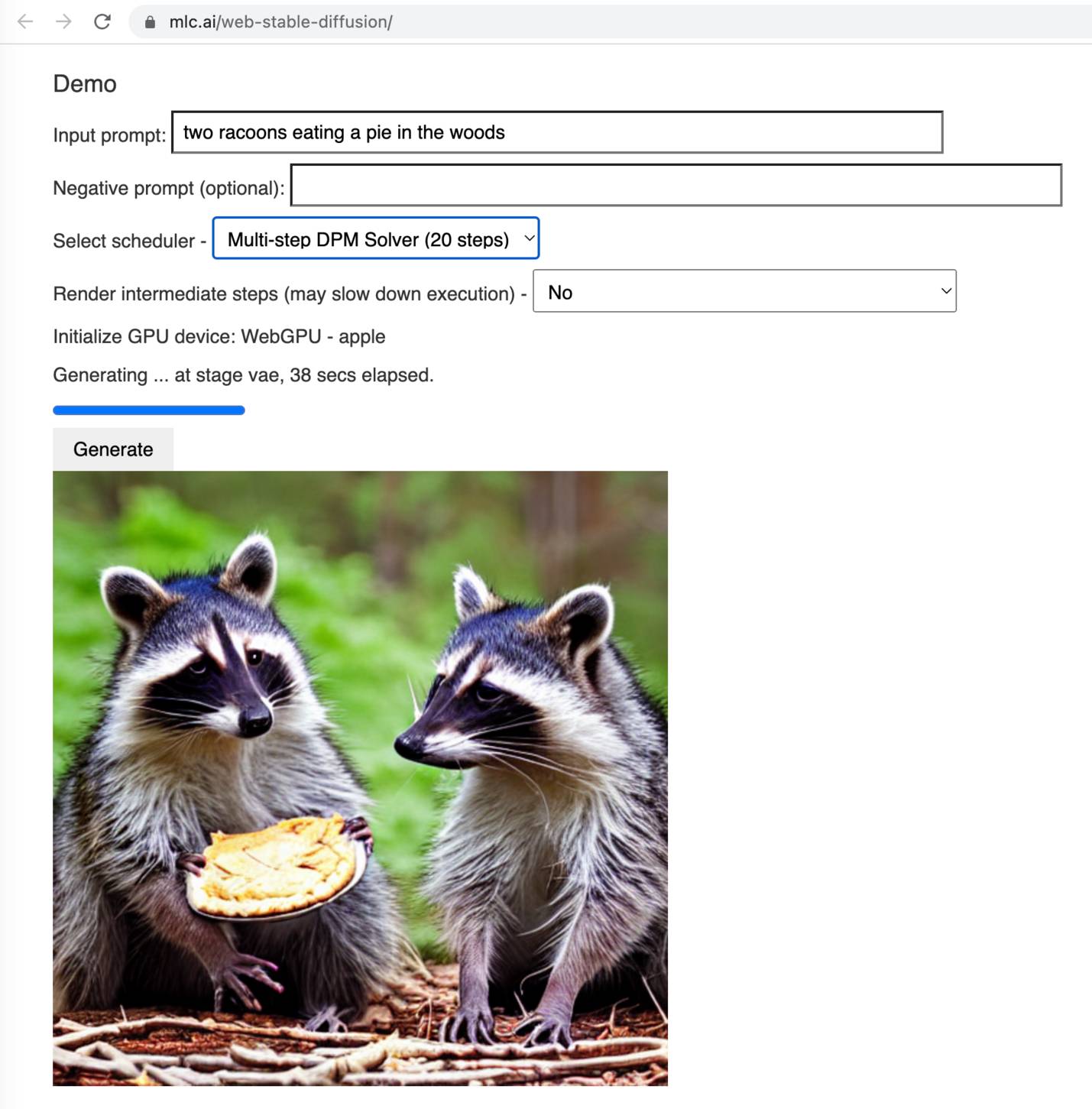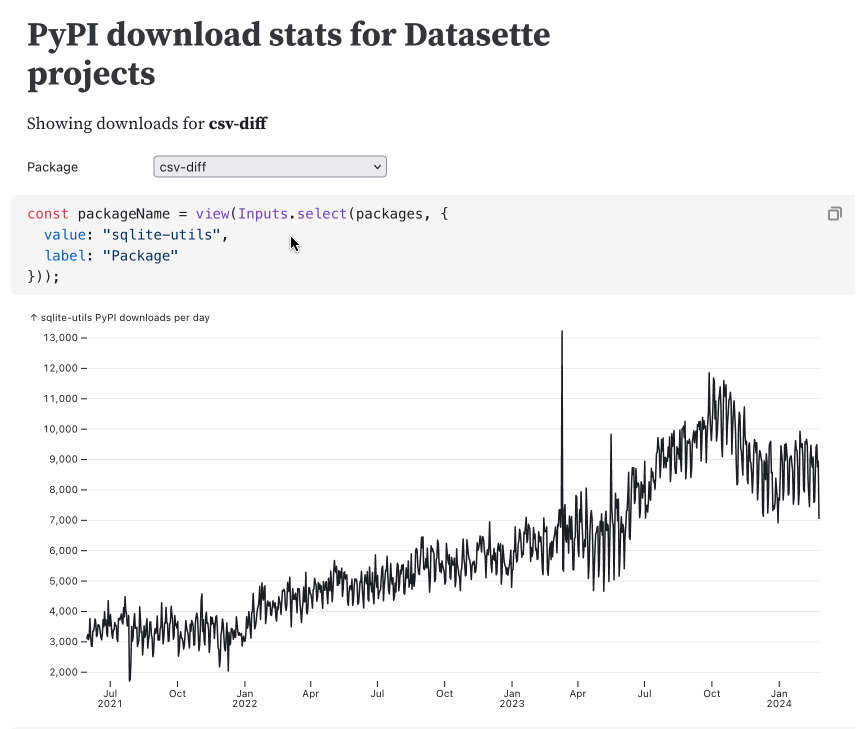732 posts tagged “javascript”
2024
Observable Framework 1.1 (via) Less than three weeks after 1.0, the 1.1 release adds a whole lot of interesting new stuff. The signature feature is self-hosted npm imports: Framework 1.0 linked out to CDN hosted copies of libraries, but 1.1 fetches copies locally and then bundles that code with the deployed static site.
This works by using the acorn JavaScript parsing library to statically analyze the code and find all of the relevant imports.
Interesting ideas in Observable Framework
Mike Bostock, Announcing: Observable Framework:
[... 2,123 words]htmz (via) Astonishingly clever browser platform hack by Lean Rada.
Add this to a page:
<iframe hidden name=htmz onload="setTimeout(() => document.querySelector( this.contentWindow.location.hash || null)?.replaceWith( ...this.contentDocument.body.childNodes ))"></iframe>
Then elsewhere add a link like this:
<a href="/flower.html#my-element" target=htmz>Flower</a>
Clicking that link will fetch content from /flower.html and replace the element with ID of my-element with that content.
Val Town Newsletter 15 (via) I really like how Val Town founder Steve Krouse now accompanies their “what’s new” newsletter with a video tour of the new features. I’m seriously considering imitating this for my own projects.
The first four Val Town runtimes
(via)
Val Town solves one of my favourite technical problems: how to run untrusted code in a safe sandbox. They're on their fourth iteration of this now, currently using a Node.js application that launches Deno sub-processes using the node-deno-vm npm package and runs code in those, taking advantage of the Deno sandboxing mechanism and terminating processes that take too long in order to protect against while(true) style attacks.
2023
ast-grep (via) There are a lot of interesting things about this year-old project.
sg (an alias for ast-grep) is a CLI tool for running AST-based searches against code, built in Rust on top of the Tree-sitter parsing library. You can run commands like this:
sg -p ’await await_me_maybe($ARG)’ datasette --lang python
To search the datasette directory for code that matches the search pattern, in a syntax-aware way.
It works across 19 different languages, and can handle search-and-replace too, so it can work as a powerful syntax-aware refactoring tool.
My favourite detail is how it’s packaged. You can install the CLI utility using Homebrew, Cargo, npm or pip/pipx—each of which will give you a CLI tool you can start running. On top of that it provides API bindings for Rust, JavaScript and Python!
HTML Web Components: An Example
(via)
Jim Nielsen provides a clear example illustrating the idea of the recently coined "HTML Web Components" pattern. It's Web Components as progressive enhancement: in this example a <user-avatar> custom element wraps a regular image, then JavaScript defines a Web Component that enhances that image. If the JavaScript fails to load the image still displays.
Web Components Will Outlive Your JavaScript Framework (via) A really clear explanation of the benefit of Web Components built using dependency-free vanilla JavaScript, specifically for interactive components that you might want to embed in something like a blog post. Includes a very neat minimal example component.
Observable notebook: Detect objects in images (via) I built an Observable notebook that uses Transformers.js and the Xenova/detra-resnet-50 model to detect objects in images, entirely running within your browser. You can select an image using a file picker and it will show you that image with bounding boxes and labels drawn around items within it. I have a demo image showing some pelicans flying ahead, but it works with any image you give it - all without uploading that image to a server.

Draggable objects (via) Amit Patel’s detailed write-up of a small but full-featured JavaScript function for creating draggable objects, with support for both mouse and touch devices “using browser features that are widely supported since 2020”.
Perplexity: interactive LLM visualization (via) I linked to a video of Linus Lee's GPT visualization tool the other day. Today he's released a new version of it that people can actually play with: it runs entirely in a browser, powered by a 120MB version of the GPT-2 ONNX model loaded using the brilliant Transformers.js JavaScript library.
Someone asked me today if there was a case for using React in a new app that doesn't need to support IE.
I could not come up with a single reason to prefer it over Preact or (better yet) any of the modern reactive Web Components systems (FAST, Lit, Stencil, etc.).
One of the constraints is that the team wanted to use an existing library of Web Components, but React made it hard. This is probably going to cause them to favour Preact for the bits of the team that want React-flavoured modern webdev.
It's astonishing how antiquated React is.
Deno 1.34: deno compile supports npm packages.
This feels like it could be extremely useful: Deno can load code from npm these days (import { say } from "npm:cowsay@1.5.0") and now the deno compile command can resolve those imports, fetch all of the dependencies and bundle them together with Deno itself into a single executable binary. This means pretty much anything that's been built as an npm package can now be easily converted into a standalone binary, including cross-compilation to Windows x64, macOS x64, macOS ARM and Linux x64.
Instant colour fill with HTML Canvas
(via)
Shane O'Sullivan describes how to implement instant colour fill using HTML Canvas and some really clever tricks with Web Workers. A new technique to me is passing a canvas.getImageData() object to a Web Worker via worker.postMessage({action: "process", buffer: imageData.data.buffer}, [imageData.data.buffer]) where that second argument is a list of objects to "transfer ownership of" - then the worker can create a new ImageData(), populate it and transfer ownership of that back to the parent window.
Building a Signal Analyzer with Modern Web Tech (via) Casey Primozic’s detailed write-up of his project to build a spectrogram and oscilloscope using cutting-edge modern web technology: Web Workers, Web Audio, SharedArrayBuffer, Atomics.waitAsync, OffscreenCanvas, WebAssembly SIMD and more. His conclusion: “Web developers now have all the tools they need to build native-or-better quality apps on the web.”
@neodrag/vanilla (via) “A lightweight vanillaJS library to make your elements draggable”—I stumbled across this today while checking out a Windows 11 simulator built in Svelte. It’s a neat little library, and “download-esm @neodrag/vanilla” worked to grab me an ECMAScript module that I could import and use.
download-esm: a tool for downloading ECMAScript modules
I’ve built a new CLI tool, download-esm, which takes the name of an npm package and will attempt to download the ECMAScript module version of that package, plus all of its dependencies, directly from the jsDelivr CDN—and then rewrite all of the import statements to point to those local copies.
[... 1,240 words]On Endings: Why & How We Retired Elm at Culture Amp (via) Culture Amp made extensive use of Elm—a ML-like functional language that compiles to JavaScript—between 2016 and 2020 while building their company’s frontend. They eventually decided to move away from it, for reasons described at length in this post primarily relating to its integration with React. This piece is worth reading mainly as a thoughtful approach to engineering management challenge of deprecating a well-loved piece of technology from the recommended stack at a company.
SvelteKit is written in JS and distributed as source code — no build step — and it's been miraculous for productivity. build steps make sense for apps, they make much less sense for libraries
Web Stable Diffusion (via) I just ran the full Stable Diffusion image generation model entirely in my browser, and used it to generate an image of two raccoons eating pie in the woods. I had to use Google Chrome Canary since this depends on WebGPU which still isn't fully rolled out, but it worked perfectly.

Transformers.js. Hugging Face Transformers is a library of Transformer machine learning models plus a Python package for loading and running them. Transformers.js provides a JavaScript alternative interface which runs in your browser, thanks to a set of precompiled WebAssembly binaries for a selection of models. This interactive demo is incredible: in particular, try running the Image classification with google/vit-base-patch16-224 (91MB) model against any photo to get back labels representing that photo. Dropping one of these models onto a page is as easy as linking to a hosted CDN script and running a few lines of JavaScript.
Writing Javascript without a build system (via) Julia Evans perfectly captures why I prefer not to use build systems in the majority of my projects that use JavaScript: “... my experience with build systems (not just Javascript build systems!), is that if you have a 5-year-old site, often it’s a huge pain to get the site built again. And because most of my websites are pretty small, the advantage of using a build system is pretty small.”
Examples of floating point problems (via) I learned so much practical stuff from this post by Julia Evans. There are no 32-bit floating point numbers between 262144.0 and 262144.03125, which breaks code that attempts to keep incrementing by 0.01. I knew about the JavaScript tweet ID problem (JavaScript can’t handle numbers like 1612850010110005250) but I didn’t realize it affected jq as well. Lots more great examples in here.
Retiring Pinafore (via) Nolan Lawson built Pinafore, which became my default Mastodon client on both desktop and mobile over the past month. He thoughtfully explains why he’s ending his involvement in the project—and why, for trust reasons, he’s not planning on handing over the reigns to someone else. Pinafore is everything I want a good SPA to be—it loads fast, works offline and packs a whole lot of functionality into a tiny package. I’m sad to see Nolan’s involvement come to end—it’s a superb piece of software.
2022
Draw SVG rope using JavaScript (via) Delightful interactive tutorial by Stanko Tadić showing how to render an illustration of a rope using SVG, starting with a path. The way the tutorial is presented is outstanding.
three.js examples: webgl_postprocessing_pixel (via) Neat new example for three.js that uses a pixel-shader postprocessor to apply an isometric pixel-art feel to a 3D scene.
About the sqlite3 WASM/JS Subproject. SQLite now maintains an official WebAssembly build. It’s influenced by sql.js but is a fresh implementation with its own API design. It also supports Origin-Private FileSystem (OPFS)—a very new standard which doesn’t yet have wide browser support that allows websites to save and load files using a dedicated folder on the host machine.
Fastly Compute@Edge JS Runtime (via) Fastly’s JavaScript runtime, designed to run at the edge of their CDN, uses the Mozilla SpiderMonkey JavaScript engine compiled to WebAssembly.
Shoelace (via) Saw this for the first time today: it’s a relatively new library of framework-agnostic Web Components, built on lit-html and covering a huge array of common functionality: buttons and sliders and dialogs and drawer interfaces and dropdown menus and so on. The design is very clean, the documentation is superb—and it looks like you can cherry pick just the components you are using for a pretty lean addition to your page weight. So refreshing to see libraries like this that really take advantage of modern web standards.
Promise Maps. Egbert Teeselink describes a neat JavaScript caching pattern: instead of caching key:value cache key:promise-that-resolves-to-value—doing this gives you dog piling prevention for free, because the first lookup of a value trigers the computation to fetch it while subsequent lookups wait on the same promise to resolve—or resolve instantly if the computation has completed.

